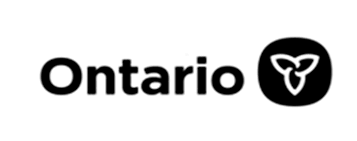
In this article, Adelaide RIDER-NICHOLSON (ESSEC Business School, Global Bachelor in Business Administration (GBBA) – Exchange Student, 2025) shares their internship experience with the Government of Canada at the Ministry of Citizenship and Multiculturalism. They explore the structure of the Ministry, its mandate, and their involvement in policy research and community engagement projects.
About the Ministry of Citizenship and Multiculturalism
The Ministry of Citizenship and Multiculturalism is a part of the Government of Canada and is responsible for advancing inclusive policies, promoting multicultural values, and ensuring that newcomers and minority communities are supported through public services and community initiatives. The Ministry plays a critical role in shaping Canada’s multicultural identity and ensuring equitable access to opportunities across all communities.
Logo of Government of Ontario.

Source: the Government of Ontario.
As a public institution, the Ministry’s focus is not profit-driven but centered on social impact, public service, and civic responsibility. Its work ranges from supporting newcomer integration, funding ethnocultural community organizations, and developing anti-racism strategies to promoting civic engagement and Canadian values of pluralism and diversity.
The Working Process
Like many public service departments, the Ministry follows a structured approach to designing and implementing programs. This process often involves:
Step 1: Policy Mandate & Strategic Planning
All projects begin with a mandate from the provincial or federal government. These directives outline focus areas — such as improving access to services for racialized communities or enhancing civic education among youth. Strategic planning follows, during which interdepartmental teams define objectives, allocate resources, and consult stakeholders.
Step 2: Research and Community Engagement
To ensure that initiatives reflect lived experiences, the Ministry often conducts stakeholder engagement, community consultations, and data analysis. As an intern, I was involved in this step—compiling demographic reports, preparing surveys, and participating in virtual town halls with community leaders and non-governmental organizations (NGOs).
Step 3: Policy Development and Program Delivery
Once the research and feedback are analyzed, policy advisors draft policy proposals or refine programs. These may include funding frameworks, anti-racism toolkits, or educational materials. Interns assist by reviewing comparative policy models, drafting briefing notes, or supporting communications plans for public outreach.
Each level of the organization plays a specific role—from data collection and research at the analyst level to shaping the long-term vision of the Ministry at the executive level. Cross-functional teamwork is essential, especially between communications, operations, and policy units.
Work Environment & Ethics
Working at the Ministry was defined by its strong commitment to equity, inclusion, and accountability. Unlike the private sector, timelines are often influenced by legislative cycles and public consultations, which means balancing patience with precision. The emphasis on confidentiality and clarity in communication is paramount—every briefing note or report may eventually inform public policy.
Colleagues were incredibly supportive and willing to share their career journeys in public service. Weekly check-ins, mentorship coffee chats, and access to learning portals created a welcoming and growth-oriented atmosphere.
One important takeaway was the Ministry’s emphasis on evidence-based policy—decisions were never rushed and were always informed by extensive research and inclusive dialogues.
Required skills and knowledge
During my internship at the Ministry of Citizenship and Multiculturalism, I developed a balanced mix of hard and soft skills essential for a career in public policy and beyond. On the technical side, I strengthened my analytical abilities by working with demographic data, preparing briefing notes, and evaluating policy frameworks with measurable outcomes. I also became proficient in using government reporting tools and adhering to formal policy-writing standards. Equally important were the soft skills I honed: navigating cross-cultural communication during community consultations, adapting to a formal bureaucratic environment, and presenting complex findings in a clear, accessible way for both internal and public stakeholders. These experiences sharpened my critical thinking, diplomacy, and attention to detail—skills that are invaluable for any ESSEC student aiming to lead responsibly in business, government, or international organizations.
What I learned
One of the most impactful lessons I learned during my internship was how deeply interconnected public policy is with real-world social outcomes. I gained a clearer understanding of how decisions made at the ministry level directly influence funding for grassroots organizations, support for immigrant communities, and the implementation of inclusive practices across the province. I also came to appreciate the importance of patience and persistence in government work—policy change is often gradual, requiring continuous stakeholder engagement and rigorous documentation. Perhaps most importantly, I learned how to approach complex social challenges with a structured, evidence-based mindset, and how public institutions balance political direction with long-term societal goals.
Financial concepts related to my internship
I present below three financial concepts related to my internship: public budgeting, cost-benefit analysis, and grant funding allocation. These concepts were central to my work at the Ministry of Citizenship and Multiculturalism and helped me understand how financial principles are applied in public policy decision-making.
Public Budgeting
Public budgeting is the process by which government departments plan, allocate, and manage financial resources in alignment with policy goals. During my internship, I observed how the Ministry sets budget priorities based on strategic objectives such as promoting multiculturalism and supporting newcomer integration. This involved reviewing financial plans, aligning spending with program goals, and ensuring accountability in how public funds are used. Through this, I gained an understanding of how budgets are not just numbers but reflect broader social and political commitments.
Cost-Benefit Analysis
Cost-benefit analysis (CBA) is a tool used to evaluate the efficiency of public programs by comparing expected costs with anticipated benefits. I encountered this concept while working on internal policy reviews, where analysts used CBA to assess the viability of expanding or adjusting government initiatives. For example, I contributed to a report evaluating the effectiveness of community grants in reducing barriers for racialized youth. CBA helped inform whether the social outcomes achieved justified the public investment, which is crucial for responsible policy-making.
Grant Funding Allocation
Grant funding allocation refers to the process of distributing government funds to external organizations that align with specific policy objectives. One of my key tasks was helping review grant applications from community groups. This required assessing the financial soundness of proposals, projected outcomes, and how well each initiative aligned with Ministry goals. I learned how financial evaluation, transparency, and strategic impact all factor into deciding which organizations receive public funding. This experience deepened my appreciation for the financial scrutiny that underpins every public dollar awarded.
Why should I be interested in this post?
For an ESSEC student passionate about business, finance, and public impact, this internship experience highlights how government institutions like the Ministry of Citizenship and Multiculturalism play a vital role in shaping inclusive economic policies and managing resource allocation across diverse communities. Understanding how policy is developed, funded, and implemented not only broadens your perspective on governance but also strengthens your ability to assess financial decisions through a social lens. This exposure is especially relevant for those aiming to work in ESG investing, impact consulting, or public-private partnerships—where financial strategy and social responsibility go hand in hand.
Related posts on the SimTrade blog
▶ All posts about Professional experiences
▶ Talia HAMMOUD My internship experience at Little Friends for Peace
▶ Louise PIZON Village Community Bank (VICOBA)
Useful resources
Government of Canada – Multiculturalism and Anti-Racism Program – Official site providing information on funding programs and strategies to promote equity and inclusion.
Statistics Canada – Immigration and Ethnocultural Diversity Statistics – Demographic data and analytical reports essential for evidence-based policy decisions.
OECD – Public Integrity – International best practices and frameworks on transparency and ethical governance.
Treasury Board of Canada Secretariat – Policy on Results – Framework for planning, measuring, and reporting on public sector performance.
About the author
The article was written in May 2025 by Adelaide RIDER-NICHOLSON (ESSEC Business School, Global Bachelor in Business Administration (GBBA) – Exchange Student, 2025).
